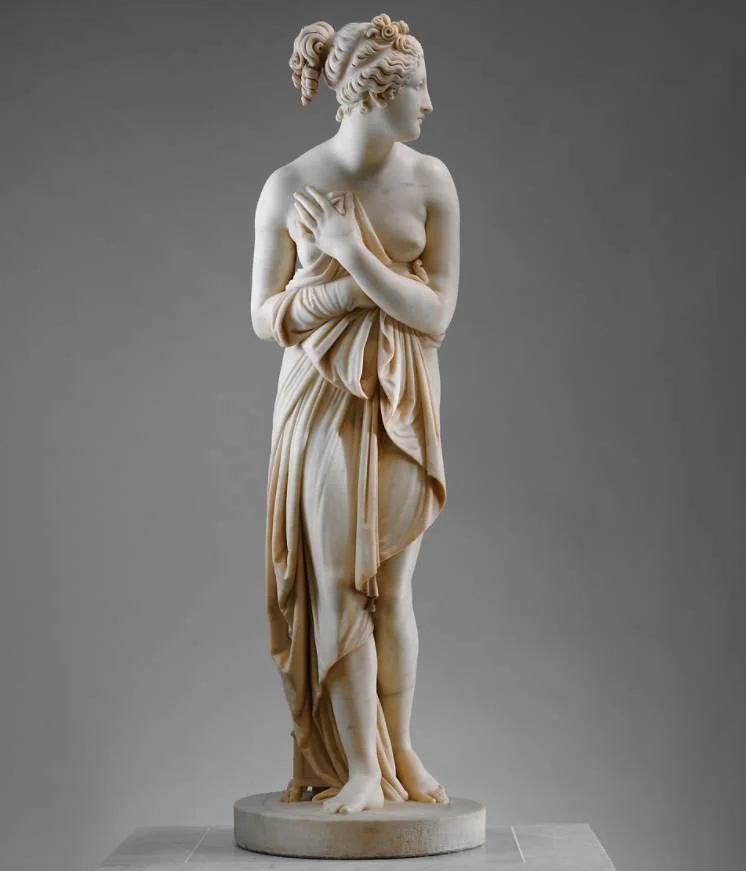Even though Antonio Canova (1757-1822) is considered to be one of the most famous Neoclassical artists in history, he managed to develop his style. This was a unique mix of the cold and austere works from antiquity and the dramatic works created by Baroque artists.
This unique approach turned him into one of the most popular artists of his time, resulting in commissions from some of the most important people in Europe.
This includes a work called “Venus Italica,” perhaps not his best-known work but still a sculpture that has some interesting stories to tell.
1. The sculpture was completed in the early 19th century
Venus Italica is one of the sculptures that define the ability of Antonio Canova, a man who was able to replicate real human flesh in marble. That’s why he earned commissions from world leaders at the time, including Napoleon Bonaparte.
This particular sculpture was commissioned by Ludovico I, King of Etruria (1773-1803), in the early 19th century. Unfortunately, the king never managed to see the sculpture completed because he died in 1803, a year before it was delivered by Canova and his workshop in 1804.

2. It was intended to replace a sculpture created in antiquity
Even though Napoleon didn’t have a hand in the commission of the sculpture, he did have everything to do with the reason why it was commissioned in the first place.
The king ordered it from Canova to replace the Venus de’ Medici, a sculpture from antiquity dating back to the 1st century B.C. It was discovered in Rome and eventually made its way to Florence and put on display at the Uffizi Gallery.
From here, the ancient sculpture was moved to the Louvre Museum in Paris to decorate the “Musée Napoleon” as it was called back then. In other words, it was confiscated on orders of Napoleon himself.
3. The classical sculpture is still located in Florence today
Venus de’ Medici was an extremely influential sculpture, the main reason why Napoleon ordered it to be brought to Paris in 1802.

Even though it stayed in Paris for about 13 years, it was eventually brought back to Florence following the ultimate Fall of Napoleon in 1815.
It’s still on public display at a room especially designed for it called the “Room of Venus” in the “Galleria Palatina” of the Imposing Palazzo Pitti in Florence.
4. The classical Venus was also a copy of an even older work
Canova didn’t merely copy the Venus de’ Medici, a work that depicts the Greek goddess Aphrodite and which stands 1.53 meters (5 feet) tall.
What’s remarkable is that the classical version of the sculpture is a copy of an older piece.
Even though the exact details aren’t known, it’s assumed that this copy was produced in Athens. A man called “Cleomenes of Athens” is believed to be the sculptor of an even older bronze statue of which this marble version is a copy.

5. The original work by Canova is also located in Florence
One of the most interesting facts about Venus Italica is that both the ancient sculpture called the Venus de’ Medici and the original version of Antonio Canova are located in the same location.
This means that you can admire Canova’s work in the “Room of Venus” in the “Galleria Palatina” of the Pitti Palace in Florence as well.
The Pitti Palace, the former residence of the Dukes of Tuscany, has been an integral part of the Uffizi Gallery since 2015 and holds an incredible collection of fine art.
6. The sculpture has been described as one of his most subtle works
The unique ability of Antonio Canova to recreate human flesh in marble is especially highlighted in Venus Italica.
Even more so than in the work, which he completed in 1787, called “Psyche Revived by Cupid’s Kiss” and a work completed between 1805 and 1808 depicting Pauline Bonaparte called “Venus Victrix.”
That’s why the work has been described as one of his most subtle creations, and that means something. What better person to describe the work than one of his contemporaries in 1811, a poet named Ugo Foscolo, who wrote:
I sighed with a thousand desires, for really, if the Medici Venus is a most beautiful goddess, this is a most beautiful woman.”
7. It’s unclear how many copies of this sculpture were created
By the time that this sculpture was completed, Canova already had a large and established workshop with numerous assistants working for him. These people carved the block of marble until a certain point, and Canova himself put the final touches to it.
He completed two phases:
- Direct touch – A process that could take weeks or even months in which he turned marble into flesh using special tools.
- Last touch – The final phase in the process in which he used patina in order to enhance the skin tone of the sculpture.
Because this sculpture was such an enormous success, it’s unknown how many replicas he eventually ended up completing.
8. You can admire an exact replica in a famous museum in New York
Even though the exact number of replicas remains unknown, we do know that they are scattered around in museums all around the world.
One of these sculptures was completed anywhere between 1822 and 1823 and was originally bought by the third marquess of Londonderry in 1827. This statue decorated Londonderry House in London until the year 1962.
Today, it’s part of the extensive collection of the Metropolitan Museum of Art (MET) in New York City on 5th Avenue. It’s located in Gallery 515 of this immense museum

